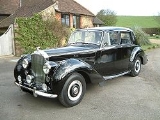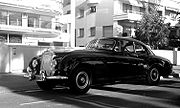
Bentley R Type
Encyclopedia
The R Type is the second series of post-war
Bentley automobiles, replacing the Mark VI
. Essentially a larger-boot version of the Mk VI, the R type is regarded by some as a stop-gap before the introduction of the S series cars in 1955. As with its predecessor, a standard body
was available as well as coachbuilt versions by firms including H. J. Mulliner & Co.
, Park Ward
, Harold Radford
, Freestone and Webb
and others. Even by this date, there was little difference (other than the radiator grilles and the carburation) between the standard Bentley R Type and the Rolls Royce Silver Dawn, though Bentley was still the more popular marque. The vast majority of cars produced were Bentleys. Some 2,500 units were manufactured during the R Type's run.
available from the dwindling number of UK coachbuilders. These ranged from the grand flowing lines of Freestone and Webb's conservative, almost prewar shapes, to the practical conversions of Harold Radford which including a clamshell style tailgate and folding rear seats.
-head straight-6
engine fed by twin SU Type H6 carburettors. The basic engine displaced 4.6 L (4566 cc/278 in³) with a 92.08 mm (3.6 in) bore and 114.3 mm (4.5 in) stroke. A 4-speed manual transmission
was standard with a 4-speed automatic
option becoming standard on later cars.
in 1953 had a top speed of 101.7 mph (163.7 km/h) and could accelerate from 0-60 mph (96.6 km/h) in 13.25 seconds. A fuel consumption of 15.5 mpgimp was recorded. The test car cost £4481 including taxes.
 Despite its name, the two-door Continental was produced principally for the domestic home market, the majority of cars produced (165, including a prototype
Despite its name, the two-door Continental was produced principally for the domestic home market, the majority of cars produced (165, including a prototype
) being right-hand drive, with a 43 left-hand drive examples produced for use abroad. The chassis was produced at the Rolls Royce Crewe factory and shared many components with the standard R type. Other than the R-Type standard steel saloon, R-Type Continentals were delivered as rolling chassis to the coachbuilder
of choice. Coachwork for most of these cars was completed by H. J. Mulliner & Co.
who mainly built them in fastback coupe form. Other coachwork came from Park Ward
(London) who built six, later including a drophead coupe version. Franay (Paris) built five, Graber (Wichtrach, Switzerland) built three, one of them later altered by Köng (Basle, Switzerland), and Pininfarina
made one. James Young
(London) built in 1954 a Sports Saloon for the owner of the company, James Barclay.
The early R Type Continental has essentially the same engine as the standard R Type, but with modified carburation, induction and exhaust manifolds along with higher gear ratios. After July 1954 the car was fitted with an engine, having now a larger bore of 94.62 mm (3.7 in) with a total displacement of 4.9 L (4887 cc/298 in³). The compression ratio was raised to 7.25:1.
Post-war
A post-war period or postwar period is the interval immediately following the ending of a war and enduring as long as war does not resume. A post-war period can become an interwar period or interbellum when a war between the same parties resumes at a later date...
Bentley automobiles, replacing the Mark VI
Bentley Mark VI
The Bentley Mark VI was the first post-war luxury car from Bentley.Announced in May 1946 and produced from 1946 to 1952 it was also both the first car from Rolls-Royce with all-steel coachwork and the first complete car assembled and finished at their factory...
. Essentially a larger-boot version of the Mk VI, the R type is regarded by some as a stop-gap before the introduction of the S series cars in 1955. As with its predecessor, a standard body
John Polwhele Blatchley
John Polwhele Blatchley was a London-born car designer known for his work with J Gurney Nutting and Rolls-Royce Limited.-Career:...
was available as well as coachbuilt versions by firms including H. J. Mulliner & Co.
H. J. Mulliner & Co.
H. J. Mulliner & Co. was a well-known British coachbuilder operating at Chiswick in West London.The Mulliner family can trace their coachbuilding history back to 1760, building coaches for the Royal Mail in Northampton....
, Park Ward
Park Ward
Park Ward was a British coachbuilder founded by William M. Park and Charles W. Ward in 1919. They had worked together at F.W. Berwick Ltd., the makers of Sizaire-Berwick cars.Their business operated from Willesden, North London.-History:...
, Harold Radford
Harold Radford
Harold Radford & Co Limited of Melton Court, South Kensington, London SW7, were bespoke coachbuilders. The business began in the late 1940s making relatively minor changes to bodywork for owners of new Bentleys, amendments to suit the rural lifestyle of the landed gentry...
, Freestone and Webb
Freestone and Webb
Freestone and Webb were an English coachbuilder, most notably for Rolls-Royce and Bentley motor cars.The company was formed in 1923 by V.E. Freestone and A.J. Webb as a specialist coachbuilding service, based in workshops in Brentfield Road, Willesden, North London, which became its home for its...
and others. Even by this date, there was little difference (other than the radiator grilles and the carburation) between the standard Bentley R Type and the Rolls Royce Silver Dawn, though Bentley was still the more popular marque. The vast majority of cars produced were Bentleys. Some 2,500 units were manufactured during the R Type's run.
Design
During development it was referred to as the Bentley Mark VII. Indeed the chassis cards for these cars describe them as Bentley 7. The R Type name which is now usually applied stems from chassis series RT. The front of the saloon model was identical to the Mark VI, but the boot (trunk) was almost doubled in capacity and the engine increased in displacement from 4.25 to 4.5 litres (as fitted to the later Mark VI). For buyers looking for a more distinctive car, a decreasing percentage had custom coachworkCoachwork
Coachwork is the body of a horse-drawn coach or carriage, a motor vehicle , a railroad car or railway carriage. Usually reserved for bodies built on a separate chassis, rather than being of unitary or monocoque construction...
available from the dwindling number of UK coachbuilders. These ranged from the grand flowing lines of Freestone and Webb's conservative, almost prewar shapes, to the practical conversions of Harold Radford which including a clamshell style tailgate and folding rear seats.
Running gear
All R Type models use an iron-block/aluminiumAluminium
Aluminium or aluminum is a silvery white member of the boron group of chemical elements. It has the symbol Al, and its atomic number is 13. It is not soluble in water under normal circumstances....
-head straight-6
Straight-6
The straight-six engine or inline-six engine is a six-cylinder internal combustion engine with all six cylinders mounted in a straight line along the crankcase...
engine fed by twin SU Type H6 carburettors. The basic engine displaced 4.6 L (4566 cc/278 in³) with a 92.08 mm (3.6 in) bore and 114.3 mm (4.5 in) stroke. A 4-speed manual transmission
Manual transmission
A manual transmission, also known as a manual gearbox or standard transmission is a type of transmission used in motor vehicle applications...
was standard with a 4-speed automatic
Automatic transmission
An automatic transmission is one type of motor vehicle transmission that can automatically change gear ratios as the vehicle moves, freeing the driver from having to shift gears manually...
option becoming standard on later cars.
Brakes and suspension
The suspension was independent at the front using coil springs with semi elliptic leaf springs at the rear. The powerful brakes used 12.25 in (311 mm) drums all round and were operated hydraulically at the front and mechanically at the rear via a gearbox driven servo.Performance
A four door saloon with automatic transmission tested by the British magazine The MotorThe Motor (magazine)
The Motor was a British weekly car magazine founded on 28 January 1903....
in 1953 had a top speed of 101.7 mph (163.7 km/h) and could accelerate from 0-60 mph (96.6 km/h) in 13.25 seconds. A fuel consumption of 15.5 mpgimp was recorded. The test car cost £4481 including taxes.
R-Type Continental

Prototype
A prototype is an early sample or model built to test a concept or process or to act as a thing to be replicated or learned from.The word prototype derives from the Greek πρωτότυπον , "primitive form", neutral of πρωτότυπος , "original, primitive", from πρῶτος , "first" and τύπος ,...
) being right-hand drive, with a 43 left-hand drive examples produced for use abroad. The chassis was produced at the Rolls Royce Crewe factory and shared many components with the standard R type. Other than the R-Type standard steel saloon, R-Type Continentals were delivered as rolling chassis to the coachbuilder
Coachbuilder
A coachbuilder is a manufacturer of bodies for carriages or automobiles.The trade dates back several centuries. Rippon was active in the time of Queen Elizabeth I, Barker founded in 1710 by an officer in Queen Anne's Guards, Brewster a relative newcomer , formed in 1810. Others in Britain included...
of choice. Coachwork for most of these cars was completed by H. J. Mulliner & Co.
H. J. Mulliner & Co.
H. J. Mulliner & Co. was a well-known British coachbuilder operating at Chiswick in West London.The Mulliner family can trace their coachbuilding history back to 1760, building coaches for the Royal Mail in Northampton....
who mainly built them in fastback coupe form. Other coachwork came from Park Ward
Park Ward
Park Ward was a British coachbuilder founded by William M. Park and Charles W. Ward in 1919. They had worked together at F.W. Berwick Ltd., the makers of Sizaire-Berwick cars.Their business operated from Willesden, North London.-History:...
(London) who built six, later including a drophead coupe version. Franay (Paris) built five, Graber (Wichtrach, Switzerland) built three, one of them later altered by Köng (Basle, Switzerland), and Pininfarina
Pininfarina
Pininfarina S.p.A. is an Italian car design firm and coachbuilder in Cambiano, Italy.Founded as Società anonima Carrozzeria Pinin Farina in 1930 by automobile designer and builder Battista "Pinin" Farina, Pininfarina has been employed by a wide variety of high-end automobile manufacturers,...
made one. James Young
James Young (coachbuilder)
James Young Ltd was a British coachbuilding company. The business was started in 1863 in LondonRoad, Bromley. originally producing horsedrawn carriages....
(London) built in 1954 a Sports Saloon for the owner of the company, James Barclay.
The early R Type Continental has essentially the same engine as the standard R Type, but with modified carburation, induction and exhaust manifolds along with higher gear ratios. After July 1954 the car was fitted with an engine, having now a larger bore of 94.62 mm (3.7 in) with a total displacement of 4.9 L (4887 cc/298 in³). The compression ratio was raised to 7.25:1.
Production numbers
- R Type: 2323 (295 with coachbuilt bodies)
- R Type Continental: 207 (plus one prototype)

